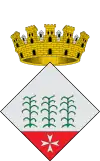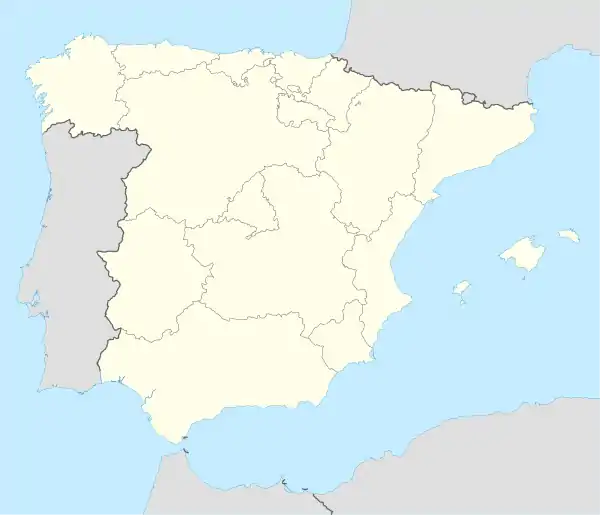Alcanar
Alcanar (Catalan pronunciation: [əlkəˈna]) is a Spanish municipality of the Catalan comarca of Montsià, in the Tarragona province. It is a coastal town on the Mediterranean Sea. The Serra del Montsià range and its foothills rise above the town and its surroundings. According to data from 2006 its population is 9,620 inhabitants, although this increased the next year, to 9,969.[4] It is the southernmost town in Catalonia, located just north of the border with the municipality of Vinaròs which is in the province of Castellón and part of the region of Valencia.
Alcanar | |
|---|---|
 Alcanar's harbour | |
 Flag  Coat of arms | |
 Alcanar Location of Alcanar  Alcanar Alcanar (Catalonia)  Alcanar Alcanar (Spain) | |
| Coordinates: 40.544°N 0.482°E | |
| Country | |
| Autonomous community | |
| Province | Tarragona |
| Comarca | Montsià |
| Government | |
| • Mayor | Alfons Montserrat Esteller (2015)[1] (ERC) |
| Area | |
| • Total | 47.1 km2 (18.2 sq mi) |
| Elevation | 72 m (236 ft) |
| Population (2018)[3] | |
| • Total | 9,402 |
| • Density | 200/km2 (520/sq mi) |
| Demonym(s) | canareus |
| Time zone | UTC+1 (CET) |
| • Summer (DST) | UTC+2 (CEST) |
| Postal code | 43530 |
| Website | www |
Villages
- Alcanar, 7,494
- Alcanar-Platja, 988
- Les Cases d'Alcanar, 1,391
- La Selleta, 96
History
It was not until the fifteenth century that Alcanar was incorporated as an independent town, but the town has been populated for a long time before then. From 1148 the town was part of the municipality of Ulldecona.[5] After it was granted independence, it received the name of the Canar, which originates from republic of its inhabitants.
The original charter was granted in February 1239, but as the stability of this settlement did not arrive until it was granted a new charter in 1252,[6][7] that date is regarded as the real foundation of the town. In 1380, the village already contained thirty families, and they were subjected to various attacks by Saracen pirates, which led to the construction of a lookout tower in the fourteenth century. As a precaution, the town was fortified and walled. In 1449, the town became independent of Ulldecona.[8]
During the war against John II of Castile, the town was occupied by troops of the king, who burned the town. During the reign of Philip II, various defence towers were built to cope with attacks by Turkish pirates, and Alcanar was again fortified.
In the Catalan Revolt of 1640-59, the town remained loyal to the king of Castile, which led to occupation of the city by Catalan troops. A similar event occurred during the Peninsular War. Later, during the First Carlist War, there was a siege of the city. The city was captured and looted by Carlist troops who held a strong position in the town for a time.[8]
Culture
The Alcanar parish church dedicated to Saint Michael (Sant Miquel in Catalan or San Miguel in Spanish) is a major feature of the municipality. The church is built in the Renaissance style, with a single nave and side chapels; it originally consisted of four bays with a semicircular apse, which disappeared in some nineteenth century rebuilding. It was then expanded with a transept, dome base and a sanctuary. It currently measures 19 metres wide and has a total height of 16 metres. The access door is a half-point arch framed by two columns, and at the top are three niches framed by a triangular pediment. The belltower has a square base and windows on each side.
On the outskirts of the village is a shrine devoted to the Mare de Déu del Remei (Our Lady of Good Remedy). It was built in the late sixteenth century and early seventeenth in a Gothic style. In the eighteenth century, a belltower, a crossing and a dome were added and the interior was expanded. Next to the shrine is the building of the former guest house in which retains a mosaic that represents the battle of Lepanto. The mosaic was part of the floor of the chapel until it was removed in the early nineteenth century, and as a result is very deteriorated. The image is venerated at the shrine is a small class of about 60 centimetres of the eighteenth century. The temple interior is decorated with a series of paintings made in 1920. The former altar pieces and part of the decoration were destroyed in 1936.

Along the coast are the defence towers, which were built between 1530 and 1630 to fend off pirates. They are all square, with door with voussoir, floor and vault. Most of them have been renovated, and are now used as houses or summer residences.
Economy and tourism
Tourism and second homes are a prominent factor in the Alcan economy. Near the Alcanar Beach, many housing developments have been built that increase the number of tourists during the summer months. One of the oldest summer residences is known as Clos de Codorniu, and once was home to King Alfonso XIII of Spain. It also has several hotels and campsites and other facilities designed to cater to tourism.
Agricultural activity continues to develop in the northern town, the furthest from the coast, mainly growing crops of oranges and clementines. Fishing remains important in Alcanar's smaller villages, and they are especially dedicated to catching prawns.[8]
Most tourists stay at the old and relatively quiet fishing village of Les Cases d'Alcanar or in Alcanar-Platja during the summer season. The small settlement of La Selleta was built by Germans[9] on a hill below the Serra del Montsià in the last half of the 20th century.[10]
See also
References
- "Ajuntament d'Alcanar". Generalitat of Catalonia. Retrieved 2015-11-13.
- "El municipi en xifres: Alcanar". Statistical Institute of Catalonia. Retrieved 2015-11-23.
- Municipal Register of Spain 2018. National Statistics Institute.
- "Idescat: Alcanar" (in Catalan). Idescat. Retrieved 2008-05-19.
- "Alcanar - Jardí vora Mar - Història i Monuments". www.turisme.alcanar.org. Archived from the original on 2007-12-21. Retrieved 2008-05-24.
- "Alcanar - Jardí vora Mar - Història i Monuments". www.turisme.alcanar.org. Archived from the original on 2007-12-21. Retrieved 2008-05-24.
- "Alcanar". www.alcanar.org. Archived from the original on 2007-10-21. Retrieved 2008-05-24.
- "Alcanar". Gran Enciclopèdia Catalana. Enciclopèdia Catalana. (in Catalan) English version
- Theodor Eichheim (Geb. 1936) - Der Tagesspiegel
- La Selleta - ein deutsches Dorf in Spanien. Baumeister 5/1977. München
External links
| Wikimedia Commons has media related to Alcanar. |
- Town Hall Webpage
- Government data pages (in Catalan)